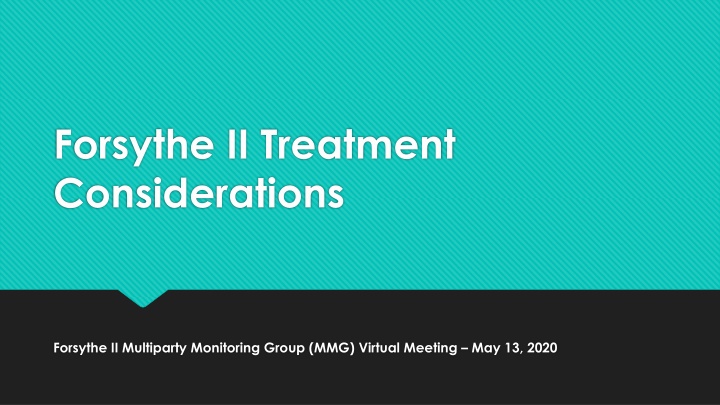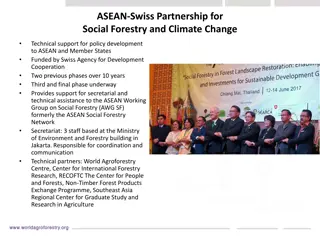Evaluation and Treatment Considerations for Forestry Management
Explore key considerations for evaluating forestry units, including values, objectives, physical characteristics, treatment impacts, methods, and prescribed fire opportunities. Understand how treatment design aligns with unit values, impacts stand conditions, and fits within the landscape context. Delve into the effects of treatments on stand structure, fuel conditions, and natural regeneration to achieve forestry management goals effectively.
Download Presentation

Please find below an Image/Link to download the presentation.
The content on the website is provided AS IS for your information and personal use only. It may not be sold, licensed, or shared on other websites without obtaining consent from the author.If you encounter any issues during the download, it is possible that the publisher has removed the file from their server.
You are allowed to download the files provided on this website for personal or commercial use, subject to the condition that they are used lawfully. All files are the property of their respective owners.
The content on the website is provided AS IS for your information and personal use only. It may not be sold, licensed, or shared on other websites without obtaining consent from the author.
E N D
Presentation Transcript
Forsythe II Treatment Considerations Forsythe II Multiparty Monitoring Group (MMG) Virtual Meeting May 13, 2020
Unit Evaluation Considerations Treatment Values and Objectives What are the values associated with this unit? What are the project objectives associated with this unit? How could the treatment design align with the values and objectives of the unit?
Unit Evaluation Considerations Unit Characteristics What are the physical characteristics of the unit (e.g., stand structure, tree species, aspect, slope, aggregations, etc.)? What resource concerns (e.g., wildlife, archaeology, botany, invasive plants, soils, etc.) are present? What are the current and desired surface fuel conditions in the unit? Are there other existing fuel considerations (e.g., ladder, crown bulk density)?
Unit Evaluation Considerations Treatment Impacts How does the treatment impact the current conditions of the stand to meet values and objectives? How does the treatment impact the future conditions of the stand to meet values and objectives? How does the treatment fit within the context of the larger landscape to meet values and objectives at a landscape level?
Unit Evaluation Considerations Treatment Methods What implementation methods will be the most efficient and effective to conduct the treatment in accordance with the values and objectives? Is it possible to use that method based on the unit s cover type, access, and slope? How many acres does the proposed treatment contribute to the acreage targets?
Prescribed Fire Treatment Considerations What opportunities should there be, if any, for future prescribed fires? General conditions needed for prescribed fires include: [Fill in here]
Mixed Conifer Treatment Considerations How do treatments impact stand structure, spatial diversity, ladder fuels, canopy breaks, and the natural regeneration of ponderosa pine (i.e., opening with nearby existing seed sources) to meet values and objectives? What opportunities are there to create a patchwork mosaic of individual, groups, and openings while meeting the values and objectives of the unit?
Aspen Treatment Considerations To what degree does the treatment expand and enhance aspen in order to meet fire, wildlife, forest health, and social objectives?
Lodgepole Pine Treatment Considerations How does the location of patchcuts align with the appropriate size class suited for the selected implementation method? If conducting future prescribed fires is a goal, to what degree can patchcuts be located adjacent to existing mixed conifer stands in order to expand potential prescribed broadcast burning area in the future?























